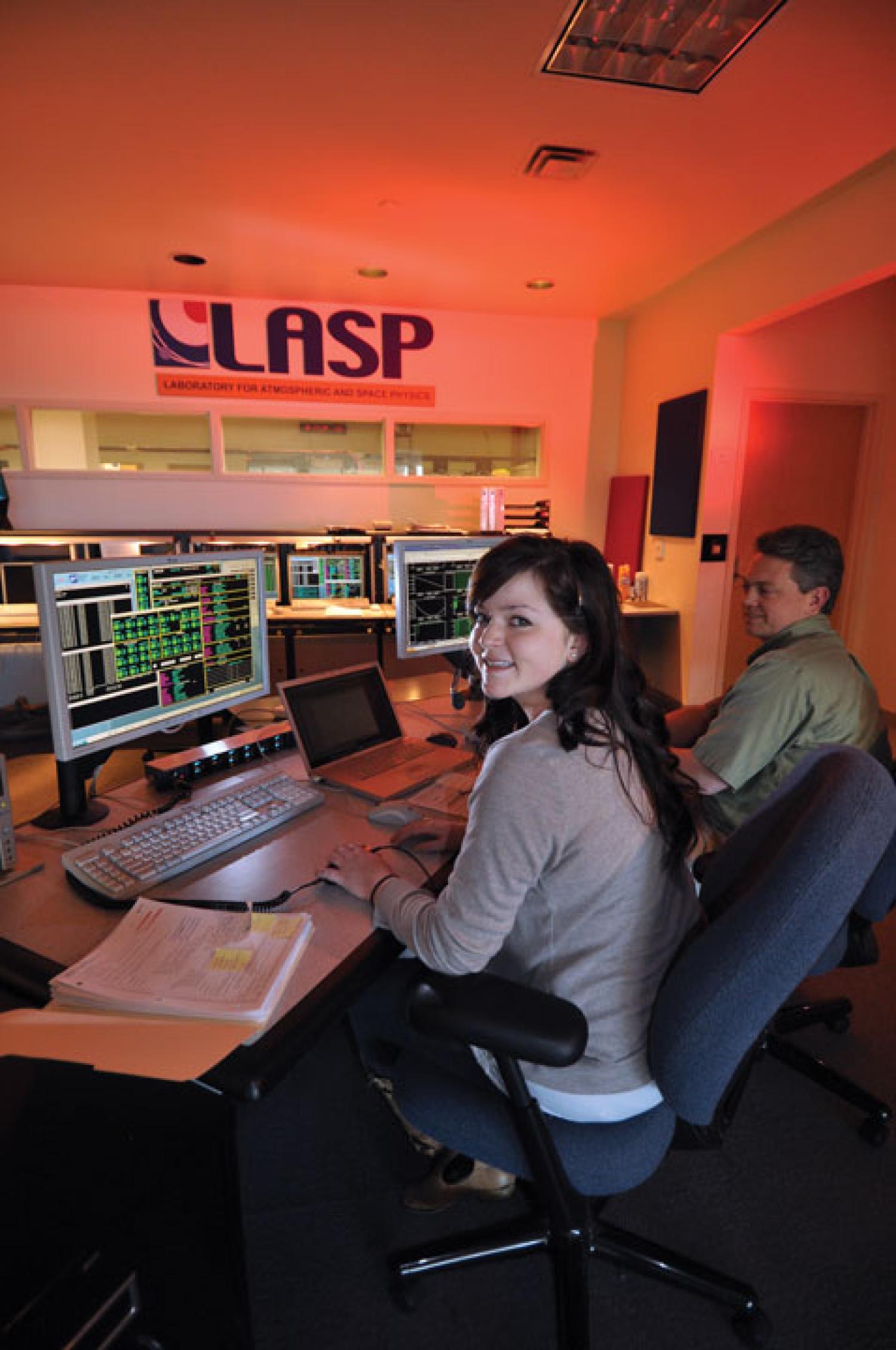
Ground Control

Who controls the satellites we see at night? Nearly 25 CU undergrads monitor four of them, collecting critical information about the Earth, sun and our galaxy.
Ever wonder what it’s like to control spacecraft? Just ask Rachael Collins. The space-obsessed 20-year-old is one of the few undergraduate students in the United States who has the opportunity to control more than a billion dollars worth of NASA-regulated spacecraft.
The University of Colorado Boulder Laboratory for Atmospheric and Space Physics (LASP) gives nearly 25 undergraduate students the reins in sending commands and monitoring data for four of NASA’s spacecraft missions.
“I’m so thrilled to be doing what I’m doing,” Collins says. “You get a lot of real world experience with this job.”
Collins was hired by LASP to help control four of its spacecraft missions.
SORCE studies the sun’s output to understand its effects on the Earth; AIM studies the upper atmospheric regions of Earth; QuikSCAT tracks winds swirling above oceans and is used in improving weather forecasts; and Kepler searches a portion of our galaxy for Earth-like planets that orbit stars similar to our sun.
“LASP offers CU students one of the most unique opportunities to work on diverse space missions compared to any university,” says Bill Possel, LASP’s director of mission operations and data systems.
To be employed at LASP as a student spacecraft operator, students must pass a rigorous training program, which includes a summer of full-time lectures, hands-on work and exams. The students then are certified to send commands, under the direction of a LASP staff member, to all four spacecraft and are assigned subsystems of the satellite or on-board instruments to monitor daily.
“It’s kind of like being the mechanic on a car,” Possel says. “Except the car is a spacecraft worth more than $100 million. They [the students] are sometimes the first ones to detect a problem on the spacecraft.”
Founded in 1948, LASP began nearly a decade before NASA emerged. Scientists from LASP started building NASA-standardized instruments for spacecraft in the ’60s and continue production today. LASP has had instruments aboard spacecraft that have orbited all of the planets in our solar system.
“Nobody else has done that outside of NASA,” Possel says, adding that every space instrument designed at LASP is engraved with the iconic Ralphie logo.
Collins mostly works with Kepler, the space telescope launched in March 2009 that focuses on approximately 100,000 stars in the area between two constellations — Cygnus and Lyra — which lie in the Orion spiral arm of our galaxy. Kepler can detect Earth-size planets up to 3,000 light years away, with less than one percent of the stars being closer than 600 light years, according to NASA. Kepler orbits the sun, converting light it captures from stars onto a pixel charge coupled device (CCD). Fluctuations in the amount of light captured can determine whether or not a star has an orbiting planet.
Rotating with other students, Collins often sits behind the computer in LASP’s control room and types Kepler its semiweekly commands, a period called “red time.” This constant contact can sometimes last for eight hours or more and is a time to confirm the spacecraft is on track with its mission and to collect its data.
“It’s a very challenging position,” Possel says. “Here they are as undergrads doing a job that a junior professional does.”
Collins, an aerospace major with a minor in astrophysics and computer science, says she is confident she will pursue a career in the industry but plans to get her master’s degree at CU first, which will be paid for by LASP. She will remain at LASP until she graduates.
“It was a perfect fit,” she says, noting she received her first telescope at age 8. “I’ve always known what I’ve wanted to do.”
During the school year all of the students employed by LASP work 20 hours a week arranged around their class schedule. Sometimes students work weekends, holidays or nights depending on the mission needs of their assigned spacecraft.
“I’ve definitely been on the graveyard shift before,” Collins says.
While sitting behind the controls is exciting, Collins’ student experience includes her roommates, who are non-aerospace majors, and she participates in ice hockey, volleyball and flag football intramural teams. For the most part, she humbly keeps her work life separate from her peers. Few know the scope of the work she does on a daily basis.
“I don’t want to sound like I’m bragging,” she says. “I’m not sure if they [her friends] fully understand the breadth of it.”

